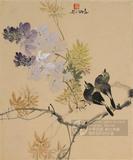宋郭熙畫山水 軸
推薦分享
資源連結
連結到原始資料 (您即將開啟新視窗離開本站)後設資料
- 資料識別:
- 故畫000059N000000000
- 資料類型:
- 類型:繪畫
- 型式:靜態圖像
- 著作者:
- 郭熙
- 主題與關鍵字:
- 樂器 橋 寺廟 江河、湖海 高士(士人、隱士) 侍從(侍女、童僕) 楊柳 溪澗、湍泉 瀑布
- 出版者:
- 數位化執行單位:國立故宮博物院
- 格式:
- 本幅 188.8x95公分、全幅 109公分
- 關聯:
- 石渠寶笈三編(乾清宮),第一冊,頁485&*故宮書畫錄(卷五),第三冊,頁56-57&*故宮書畫圖錄,第一冊,頁233-234&*郭熙河陽溫縣(今河南溫縣)人,神宗熙寧年間(西元一0六八至一0七七)為畫院藝學,善於畫山水。畫法學自李成,但能建立自己的面貌。 主峰聳立,山石重疊險峻而多變化,或如束帛,或如「馬牙」。山腳一片霧氣籠罩著,樓台隱約可見。小舟橫於柳岸,有二位士人帶著童子在小橋上漫步,能得荒江野水之幽趣。&*Kuo Hsi came from Wen-hsien in Honan. His style name was Shun-fu. He jained the Painting Academy in 1068 on command from the Emperor Shen-tsung. He was an excellent painter of landscapes. Though he modelled himself on Li Ch'eng (916-967), his paintings express his own feelings and ideas. He invented a type of landscape wall-painting in which mud was thrown onto a wall and then painted to resemble mountains and trees. He was the author of an important treatise on landscape painting. In this picture craggy peaks tower over a sheer, rugged cliff. Below a river pours over a wild, desolate plain. Fog encircles a mansion and a boat is moored among willow reeds. Two old men, accompanied by a boy carrying a lute, walk in quest of a secluded spot amid splendid scenery. In this magnificent landscape we may note especially the wonderfully painted mountains and rocks which exactly capture the mysterious atmosphere of the wild, watery plain.
- 管理權:
- 國立故宮博物院
授權聯絡窗口
- 國立故宮博物院圖像授權、出版授權、影音資料授權-申請流程說明
http://www.npm.gov.tw/zh-TW/Article.aspx?sNo=03003061






